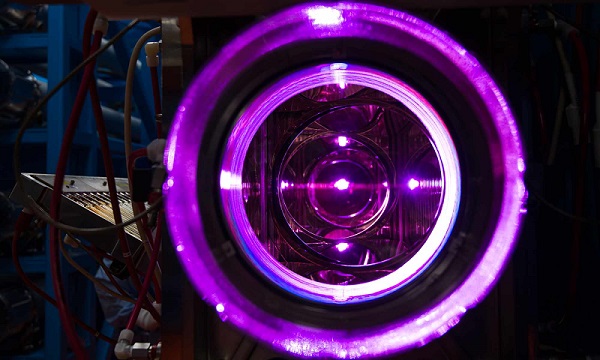Researchers at the University of Rochester’s Laboratory for Laser Energetics (LLE) have demonstrated a method that aims to make inertial confinement fusion suitable for affordable mass production. According to the researchers, the method supports the realization of a fusion power plant.
Fusion has long been viewed as an ideal energy source due to its potential to be safe, clean, cheap, and reliable. Since the early 1960s, scientists have pursued the possibility of using high-powered lasers to compress thermonuclear material long enough and at high enough temperatures to trigger ignition — the point at which the resultant output of inertial fusion energy is greater than the energy delivered to the target. Scientists at the National Ignition Facility at Lawrence Livermore National Laboratory achieved ignition in a celebrated December 2022 advancement, but many hurdles remain in making fusion energy technically and commercially viable for mass production and consumption.

View through the OMEGA laser’s 20-cm disk amplifiers at the Laboratory for Laser Energetics. In a scaled-down, proof-of-principle experiment, Rochester researchers used the laser to demonstrate a critical step in the dynamic shell concept. Courtesy of J. Adam Fenster, University of Rochester.
In the conventional approach to inertial fusion energy, a target consisting of a small amount of hydrogen fuel — in the form of the hydrogen isotopes deuterium and tritium — is frozen solid into a spherical shell. The shell is then bombarded by lasers, heating the central fuel to extreme pressures and temperatures. When these conditions are achieved, the shell collapses and ignites, undergoing fusion.
The process releases an enormous amount of energy that has the potential to drive a carbon-free power plant. But a fusion power plant, still a hypothetical, would require nearly a million targets per day. The current methods for fabricating targets using a frozen preparation process are costly, and the targets are difficult to produce.

The newly developed dynamic shell formation approach creates targets in which a liquid droplet of deuterium and tritium is injected into a foam capsule. When bombarded by laser pulses, the capsule develops into a spherical shell, then implodes and collapses, resulting in ignition. Dynamic shell formation does not require the costly cryogenic layering that conventional methods of generating inertial fusion energy employ, because it uses liquid targets. These targets will also be easier to make.
Rochester researcher Valeri Goncharov first described dynamic shell formation in a 2020 paper, but the concept hadn’t been demonstrated experimentally. According to the researchers, the deuterium-tritium fuel is initially in the form of a homogeneous liquid inside a wetted-foam spherical shell. “This fuel is ignited using a conventional implosion, which is preceded by a initial compression of the fuel followed by its expansion and dynamic formation of a high-density fuel shell with a low-density interior,” the researchers said.
Now, in a scaled-down, proof-of-principle experiment, the researchers used LLE’s OMEGA laser to shape a sphere of plastic foam that had the same density as deuterium-tritium liquid fuel into a shell, demonstrating a critical step in the dynamic shell concept.
To actually generate fusion using the dynamic shell formation technique, future research will require lasers with longer and more energetic pulses, but the current experiment suggests that dynamic shell formation could be feasible as a path toward more practical fusion energy reactors. According to scientist Igor Igumenshchev, combining the target concept with a highly efficient laser system, which is currently under development at LLE, will further help to deliver an attractive path to fusion energy.
The research is supported by the U.S. Department of Energy National Nuclear Security Administration.
The work was published in Physical Review Letters (www.doi.org/10.1103/PhysRevLett.131.015102).